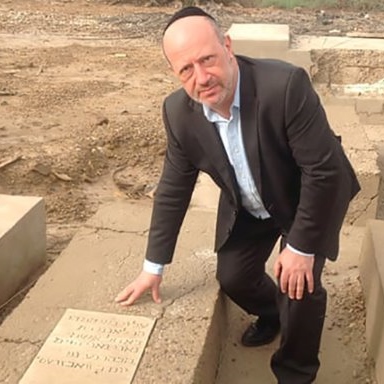click to dowload our latest edition
CLICK HERE TO SUBSCRIBE TO OUR NEWSLETTER


Published
5 years agoon
By
adminJORDAN MOSHE
The report was one of 24 personal documents involving Jewish people, including divorce bills and marriage licences.
Among them he saw his childhood photograph and grade results, left behind in another life.
“There were two school reports, one of a boy and one of a girl,” said Shuker. “I recognised the boy. He was me. I asked the curator: ‘Why did you choose these to be displayed? Are there others?’
“She said, ‘We are experts in preserving letters, but not pictures. These reports had pictures – almost all of them were underwater and we cannot recover them, except this little boy, whose picture was perfect.’
“I said, ‘Well, that boy is me.’”
This extraordinary occurrence is neither the beginning nor end of Shuker’s fascinating narrative. It’s only one step in a journey which defies belief, beginning in 1971 when Shuker and his family escaped the tyranny of former Iraqi President Saddam Hussein.
Shuker, who has been living in the United Kingdom since his flight from Iraq, returned to the Arab region in 2003 after the fall of Hussein. He decided to return to his home country out of a sense of responsibility after much deliberation and many sleepless nights.
“I was a witness to what Hussein did to the Jewish residents of Iraq,” he said. “I had a responsibility as a Jew to return. I was afraid, but from the moment I arrived in Baghdad, I experienced not one moment of fear.”
Shuker arrived to find a country under American military control, and while in the company of an army unit, he experienced an encounter that would change his life forever.
“A former Iraqi officer approached us with an unusual offer,” Shuker recounted. “He said he knew where we could find Jewish treasures that could be found nowhere else. I was sceptical, but he insisted he’d take us there if we secured asylum for him in America in exchange.”
Shuker decided to investigate, accompanied by Harold Rhode, an American Jew embedded in the Pentagon unit. Rhode was a scholar of Semitic languages, and agreed to the deal on condition that he deemed the “treasures” worthwhile.
Shuker described how the Iraqi man led them to an enormous administration building in the centre of Baghdad whose multiple levels had been drilled through top to bottom by an unexploded bomb. The bomb had come to a standstill on the ground floor, beneath which a cellar supposedly containing the trove of treasures lay. They descended cautiously.
“Harold and the team went into the cellar,” Shuker says. “What they discovered was that the bomb had destroyed the water system of the building, and the cellar was in a metre of dirty water.
“This water surrounded an enormous pile of objects. Harold started picking things up from the floor, and he realised that the entire cellar was full of documents. He pulled out a Sefer Torah and papers that had been in water for days.”
The cellar contained a veritable archive of Jewish documents. Acting quickly, Rhode called his superiors and explained the urgency of the need to extract them. Soon after being told that the ongoing conflict in Iraq was more pressing, he received a call from Natan Sharansky, whom he implored to intervene.
Shuker recounted, “Rhode said to him, ‘I’m watching our people’s history disappear in front of me. We need to save it now.’ Sharansky said he had one shot at making it happen, and ended the call.”
By some miracle, a Boeing 747 equipped with a giant freezer arrived from America within a few hours. Shuker explained that the only way to salvage the documents was to freeze them in large blocks as they were in the cellar, and transport them to America. There, they could be defrosted and handled professionally. More than 27 000 documents, primarily dating from the 20th century Iraqi Jewish community, were transported to the US.
Shuker heard nothing more about these documents until a chance occurrence on a visit to the US ten years later. He was in Washington, speaking to a group of Christians who had invited him to join them at a recently launched exhibition on the lives of Iraqi Jews at the US National Archives.
He persuaded the curator of the exhibition to give him a preview. He conducted the tour for the group after discovering that these were the same documents he’d encountered a decade earlier.
“Ninety percent of them had been saved,” he explained. “About 27 000 documents had been rescued and digitised.” The exhibition featured 28 items, among them Shuker’s school report.
“This was not just a report,” said Shuker. “It was the identity of a boy I left behind when I ran away. It was stolen from me, thrown in a cellar, and found 33 years later.
“It proves that you can’t write the Jewish people off. We can be thrown into fire or water, and threatened with annihilation, but we’ll always stay here.”
America’s possession of the documents is problematic, as it was agreed when they were removed from Iraq that they would be returned.
Shuker, who is involved in efforts to preserve the legacy of Jewry in the Arab region, is determined that the documents never get into the wrong hands again.
“Jews were part of the Arab world for centuries,” he said. “Our prophets are buried there. Seventy five percent of our Jewish sites have been stolen from us, and every time I return, there are fewer and fewer of them left.
“We need to ensure that these places, and the history of the Jews there, are not lost. One thousand years before Islam existed, Jews lived in this region. We need to preserve our history not just for ourselves, but for the Arab countries themselves. This is their history too.”
